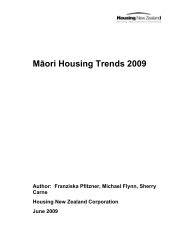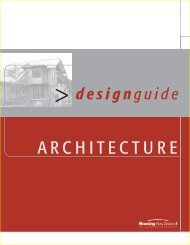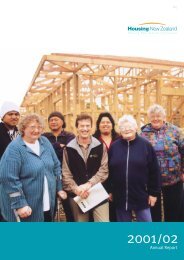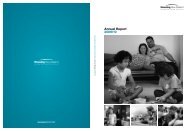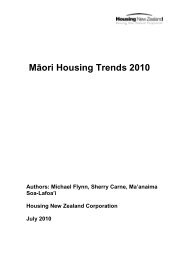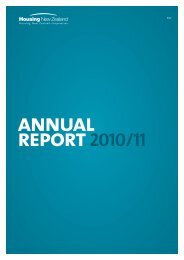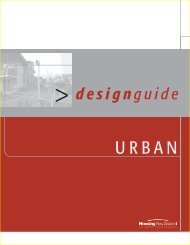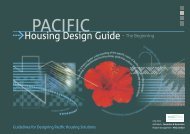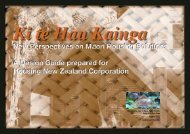Design Guide - Rural - Housing New Zealand
Design Guide - Rural - Housing New Zealand
Design Guide - Rural - Housing New Zealand
- No tags were found...
You also want an ePaper? Increase the reach of your titles
YUMPU automatically turns print PDFs into web optimized ePapers that Google loves.
designg uideRURAL
RURALINTRODUCTIONThe <strong>Rural</strong> <strong>Design</strong> <strong>Guide</strong> is to be used as a guide for highlightingprinciples and processes that are unique to a rural situation.Unlike a town or city, housing provision in rural situations will often involve:- A community rather than an individual. (More often than not thereis need for consultation with these communities, and for this reasoncommunity consultation has been highlighted in this guide as well)- Issues such as land ownership, access and infrastructure whichprovide frequent obstacles to project planning- Property values that are low- Communities involved in construction.These factors influence the challenge to design for sustainability,energy efficiency, and robustness of construction, without significantlyincreasing the costs of construction.The <strong>Rural</strong> <strong>Design</strong> <strong>Guide</strong> is split into four sections:- Land Ownership- Infrastructure Feasibility- <strong>Rural</strong> Planning- Construction.These sections contain references to topics that are:EssentialThese items are required by HNZC.Highly DesirableThese items should be included.DesirableHNZC considers these items advantageous.P 1 WL 10485
OVERVIEW OF THIS GUIDERURALIN THIS GUIDE…SECTION1LAND OWNERSHIPThe Land Ownership section focuses on determining thetype of land holding, and then on the HNZC requirements.3-6The section looks at general land and Maori land. The Maoriland section aims to introduce the reader to some of thecomplexities of the process and the Maori Land Court/HNZCrequirements where multiple ownership or Maori landis involved.SECTION2INFRASTRUCTUREAvailability of infrastructure in rural areas is important, as thecosts of taking advantage of central supplies or utilities are7-11often prohibitive. In many locations an alternative energy sourceor infrastructure provision is required. The purpose of thissection is to consider the feasibility of providing infrastructureto a proposed rural community.SECTION3RURAL PLANNINGWhere a community is planned in a rural area, unique planningissues arise. Consultation is also needed, not only with the13-18proposed occupants but often the greater community. Thissection investigates community issues, briefing and site planningfor rural projects.SECTION4CONSTRUCTIONIn a rural environment land values are often low, and ‘sweatequity’ can be used to create equity in a completed project.19-22This section goes through the unique construction issues facinghousing provision in rural areas. Skilled tradespeople are lessavailable in rural areas, and the lifestyle tends to accommodatelarge fluctuations in occupancy. Therefore robust materials andconstruction methods are desirable.©<strong>Housing</strong> <strong>New</strong> <strong>Zealand</strong> Corporation June 2002P 2
RURALSECTION1LAND OWNERSHIPBefore HNZC can become involved in aproject, the ownership of the land mustbe determined, and any issues around thatownership must be resolved. The aim ofthis section is to highlight some criticalissues that need to be dealt with prior toany initial project planning and fundingcommitment.IN THIS SECTION ON LAND OWNERSHIP…GENERAL LAND 4MAORI LAND 5HNZC recommends that, before comingto HNZC, a person wanting to developtheir land should talk to their localauthority to understand their requirements.In the case of Maori land, the personshould also talk to the registrar of theirlocal Maori Land Court.Typically in <strong>New</strong> <strong>Zealand</strong> there are threemain categories of land: Crown land (heldunder the Land Act); general land (heldunder the Land Transfer Act); and Maoriland (held under Te Ture Whenua - theMaori Land Act). This guide will onlyaddress general land and Maori land.The Land Ownership section is broken intothe following areas:General land (fee simple title)A general introduction with HNZCrequirements.Maori landA general introduction, types of ownershipstructure and HNZC requirements.P 3
SECTION 1LAND OWNERSHIPGENERAL LAND (FEE SIMPLE TITLE)RURALMost land in <strong>New</strong> <strong>Zealand</strong> held by private individuals, companies ortrusts is general land. The most common estate in general land isthe fee simple estate. The owner of a fee simple estate in generalland has all of the rights commonly associated with ownership,including the ability to grant rights in that land to others eg. thegrant of a lease or licence, or the grant of a mortgage over the landas security for a loan or other finance. The owner of a fee simpleestate in land will be recorded on the Certificate of Title for that landin the Land Transfer Office. Any transfer, lease, or mortgage of theland will also be recorded on the Certificate of Title.An example of an existing rural settlement (housesshown black) where the general land is subdividedon a fee-simple basis. The project proposal (housesshown red) intensifies the immediate area ofhousing, so their density is similar to that of a town.The new housing remains subdivided on a feesimplebasis, where common areas are furthersubdivided and owned in part by each housing unit.Before HNZC can provide assistance for the development of general land,HNZC requires the following:- A clear written agreement to the proposal signed by the owner orowners of the land - HNZC can provide an agreement relevant to theproject being proposed- A current search copy of the Certificate of Title for the property, and- A copy of the legal document or documents that set out that entity’spowers in relation to that land eg. a Trust Deed or Constitution wherethe land is owned by an entity such as a trust or an incorporated orunincorporated entity.© Common Ground.©<strong>Housing</strong> <strong>New</strong> <strong>Zealand</strong> Corporation June 2002P 4
RURALSECTION 1MAORI LANDLAND OWNERSHIPThe main type of Maori land is Maori freehold land. Maori freeholdland is land that has always been in Maori ownership. The ownershipinterests in Maori freehold land are determined and recorded in theMaori Land Court (although a record of the ownership of the landmay also be recorded in the Land Transfer Office). Because the mainrecord of ownership of Maori freehold land is held by the Maori LandCourt, most transactions involving Maori freehold land need to beconfirmed or noted by the Maori Land Court.Maori freehold land has many different characteristics. Firstly, Maori freeholdland often has multiple owners, whose shares in the land are not dividedinto separate titled lots. Secondly, Te Ture Whenua Maori (the Maori LandAct - which is the Act that governs Maori land) places restrictions on alienationof Maori freehold land eg. Maori freehold land cannot usually be sold ormortgaged in the same way as general land. These restrictions are intendedto help to retain Maori land in Maori ownership. Finally, Maori freeholdland can be held in three different ways:1 TrustMaori freehold land can be vested in a Maori trust created under TeTure Whenua Maori (Maori Land Act), and the trustees hold the landin trust for the benefit of the multiple owners of the land2 IncorporationMaori freehold land can be vested in a Maori incorporation createdunder Te Ture Whenua Maori (Maori Land Act). The incorporation holdsthe land in trust for the benefit of the multiple owners of the land, anda committee of management is usually appointed to manage andadminister the incorporation. The shares in the incorporation are heldby the owners according to their percentage interest in the land andassets held by the incorporation3 OwnersWhere Maori freehold land is not held by a trust or incorporation, thenit is simply held by all of the multiple owners of undivided shares inthe land, and decisions about use of the land, etc. must be made bythose owners.P 5
SECTION 1LAND OWNERSHIPRURALBecause of the nature of Maori freehold land, before HNZC can provide assistance for the development of Maori freehold land,HNZC requires the following:- Proof of ownership of the land (a copy of the Maori Land Court ownership records and the relevant Land TransferOffice records)- A licence to occupy the land given by the owners of the land, or the trust or incorporation in which the land is vested- A signed agreement - HNZC can provide the appropriate documentation depending on the proposal, but independent legaladvice will be required. The documents will often need to be signed by the person wanting to build or relocate a houseon the land, the owners of the land or the relevant trust or incorporation, and HNZC- The licence to occupy and the agreement (which are often combined in one document), once signed, need to be confirmedor noted by the local Maori Land Court- Note: because Te Ture Whenua Maori (Maori Land Act) restricts mortgages over Maori freehold land, HNZC will usually take amortgage over the house itself where HNZC is facilitating housing rather than providing rental properties. This chattel mortgagewill be included in a loan agreement, and will be registered with the Personal Properties Securities Register (which is a register ofchattel mortgages and other securities that are not land). The fact that there is a chattel mortgage over the house may impacton the type of house that can be built.TLAs will need to be consulted:- Even where proposed work complies with the local District Plan requirements, most TLAs usually require resource consentto be gained before any work where Maori land is involved- TLAs may also have their own distinct requirements for determining ownership where Maori land is involved- Note: for more specific information on the HNZC requirements where Maori land is involved, refer further to the HNZC PartnershipsTeam for the publication: ‘A step-by-step guide to obtaining a License to Occupy on Maori Freehold/Papakainga Land’.Te Ture Whenua Maori (Maori Land Act) restricts mortgages over Maori freehold land. HNZC willusually take a mortgage over the house, which may impact the type of house that can be built.©<strong>Housing</strong> <strong>New</strong> <strong>Zealand</strong> Corporation June 2002P 6
RURALSECTION2INFRASTRUCTURE FEASIBILITYDetermining the availability ofinfrastructure in rural areas is important,as the costs of taking advantage of centralsupplies or utilities are often prohibitiveto a project. In many locations analternative energy source or infrastructureprovision is required.IN THIS SECTION ON INFRASTRUCTURE FEASIBILITY…ACCESSSUSTAINABLE RESOURCESREQUIRED UTILITIESALTERNATIVE SOURCES8999Feasibility for the purposes of this sectionof the <strong>Rural</strong> <strong>Design</strong> <strong>Guide</strong> is consideredto be long term viability, focusing on therunning costs being able to be met by theparticular rural community in question.COST ANALYSIS 10UTILITIES REPORT 11The Infrastructure Feasibility section isbroken into the following areas:AccessOn a rural site access often first determinesthe siting of a dwellingSustainable ResourcesA study of the existing infrastructure andpossible alternatives is undertakenCost AnalysisA detailed cost analysis for the provisionof infrastructure to the siteUtilities ReportUtility findings are incorporated into asummary report.P 7
SECTION 2ACCESSINFRASTRUCTURE FEASIBILITYRURAL<strong>Rural</strong> site access is often a determining factor in the siting of adwelling. Access is highly dependant on topography. It can mean aflat area with good sun, shelter and outlook may be rendered unusableby, for example, the need to construct a bridge over a river.Access can be one of the most expensive parts of the construction cost ofa rural community or dwelling. The following is a requirement toascertain access:Engage a surveyor to undertake a site survey, and produce a planindicating contours (at a recommended minimum of 1-metre intervals)and further spot levels around an area identified by the owner/HNZCas being a potential building platform and driveway access.This project located the building platform in anarea that was inaccessible, and required anexpensive access solution. Such a solution will oftenrender a rural housing project uneconomic because,while land values are low, the initial outlay may betoo high.The plan should show:- Legal boundaries, scale, legend and north point- Contours at suitable levels- Entry access points to property- Routes of potential proposed driveways (showing gradients that areacceptable in the location and within the guidelines of the relevantDistrict Plan), and potential driveway surface treatment or materialchoice (existing or proposed)- Any walkways- Suitable building platforms- Note: as the plan will be of use when further design work is undertaken, itshould also clearly indicate positions of existing buildings, stands of trees,significant landforms, and any drainage or watercourses through the property.Refer to the relevant HNZC team whether or not they will fund thisinitial research.©<strong>Housing</strong> <strong>New</strong> <strong>Zealand</strong> Corporation June 2002P 8
SECTION 2COST ANALYSISINFRASTRUCTURE FEASIBILITYRURALOnce the availability of existing utilities (and possible alternatives)have been established, a thorough cost analysis must be completedin order to ascertain the feasibility of providing the utilities that arenot available to the building location.When considering the utility supply alternatives available to a rural setting,an environmentally sustainable resource is favoured. A cost analysis willhighlight the need to balance the desire for the use of a sustainable resourcewith affordable solutions.Complete a thorough cost analysis for infrastructure installation to a site.Use the following as a guide.1 Establishment Costs- Installation of utility (eg. new lines in for mains supply electricity).- Set up costs for an alternative (eg. supply and installation windmillfor electricity generation).2 Running costs- Average monthly supply costs (eg. mains electricity estimated usage).- Alternative energy source costs (eg. estimate of maintenance towindmill and batteries/special fittings etc.).- Other alternative fuels (eg. for water and space heating).3 Energy-cost saving measures- Energy-cost saving calculations need to factor in the use of thermalmass/siting for solar gain, insulation benefits and energy savingappliances and fittings.- This may need specialist advice to perform calculations on energysaving. Often cost-comparison information is available from thesupplier of an alternative utility device (eg. electricity/gas runningcost comparisons from supplier of gas appliances).- Note: it may be too costly to provide a 100% environmentally sustainablesolution immediately. If the initial outlay is too costly, a long-term plan touse sustainable resources should be considered. As an example, where thecapital outlay of particular system is too costly, (eg. wind powered electricitygeneration) a diesel generator could be installed in a new dwelling andprogrammed to become the backup system to the wind-poweredgenerator later.Preference for resource reliance is indicated below:1 Onsite renewable/sustainable resourcescale of preference>2 Mains supply/extraction3 Interim reliance on non-renewable resourceacceptability thresh-hold4 Non-renewable resource©<strong>Housing</strong> <strong>New</strong> <strong>Zealand</strong> Corporation June 2002P 10
RURALSECTION 2UTILITIES REPORTINFRASTRUCTURE FEASIBILITYThe utilities report is a summary of the Infrastructure Feasibility section. The purpose of the utilities report is toestablish the feasibility of a particular site.This is needed because the exact location of the building platform is often informed by the availability of utilities. A buildingsite will need access to fuel/power, water, and waste treatment utilities.After having followed through the steps covered in this section (access, availability of resources, alternative solutions, costanalysis), summarise the information into a utilities report. This report will be used by the sponsor within HNZC to determinetheir interest in continuing with the project. One possible result of this process may be that the particular site is not viable,as it is too costly to provide the utility infrastructure for the building.Another method of summarising the information for the utilities report is to include a sketch as site plan showing the features.P 11
RURAL©<strong>Housing</strong> <strong>New</strong> <strong>Zealand</strong> Corporation June 2002P 12
RURALSECTION3RURAL PLANNINGWhere a development is planned formore than one house in a rural area, uniqueplanning issues arise. Consultation isneeded, not only with the proposedoccupants but often the greater community.IN THIS SECTION ON RURAL PLANNING…COMMUNITY CONSULTATIONCONSULTATION BRIEF1416<strong>Rural</strong> communities will often have uniqueplanning approaches. They can have highdensities, mixed uses and incorporate acommunity focus.COMMUNITY FACILITIES 17SITE PLANNING 18The planning for a rural community sectionis broken into the following areas:Initiating Community ConsultationGeneral principles to be aware of whenconsulting with a communityCommunity FacilitiesCommunity support networks and proximityto proposed project locationConsultation BriefA set of guideline questions for puttingtogether a briefSite PlanningUnique rural lot, and housing layoutplanning for a community site.P 13
SECTION 3RURAL PLANNINGCOMMUNITY CONSULTATIONRURAL<strong>Housing</strong> provision in rural situations will often involve a communityrather than an individual. It is important that if a project is goingto involve or affect a community, they should be consultedappropriately. Community consultation should be the first stepin these projects. The aim of this section is to establish principlesand guidelines for that first step.Involving the community in the building processempowers them to have their needs addressed.Here are four general principles to be aware of when consulting witha community.1 Papakainga land- Papakainga lands, broadly defined, are sections of ancestral landswith defined boundaries which have never been alienated, andwhich have been defined as papakainga lands by the MaoriLand Court.- All projects providing housing on Papakainga land will involve bydefault other hapu and whanau members. These members are oftennot the proposed occupiers for the housing project, but will need tobe consulted as they are part of that Maori community group.- Where discussions are being initiated with a Maori community (oneor more hapu) for a project proposal on a particular site:- It is imperative that the iwi hierarchy is observed where theinitial consultation will be directed to the Kai Tiaki (trustee/elder)as the starting point in any discussions- This person may not end up coordinating any discussion, andmay instead refer the situation on to the relevant personor people.2 Initial consultation with any community/group should not raiseunrealistic expectations.- Promise only what you can deliver and are happy to put yourname behind.©<strong>Housing</strong> <strong>New</strong> <strong>Zealand</strong> Corporation June 2002P 14
RURALSECTION 3RURAL PLANNINGCOMMUNITY CONSULTATION3 As houses are designed with a 50 year life in mind, housing provisionshould address the longer-term needs of a community.- The following are some questions to address in such a session:- What is the housing situation in the area? Include income,lifestyle, current housing situation, etc. in this report- What is the longer term view of the owners to housingownership? Would the owners allow anyone other than theirpeople to live in the proposed housing?- What are the community facilities that the housing developmentwill need to support it? Refer for further guidance here toCommunity Facilities further on in this section.4 The purpose for any initial consultation work is to ascertain whatassistance is sought, and why it is needed.- When consulting with communities, it is important that the focusremains on the problems facing the community (eg. housingshortages, or lack of elderly care) so that a successful brief canbe developed.- The solutions should be worked through along with the appropriatetechnical and professional input as the project progresses.- Note: often communities working for housing provision in their areaswill not have the resources to provide the professional and technicalinput required. It is expected that these issues will need to be discussedwith the HNZC sponsor early in a project.Community consultation should focus on theproblems facing the community.P 15
SECTION 3RURAL PLANNINGCONSULTATION BRIEFRURALThe development of a successful brief for forming a communityproject is a priority. Once initial contact is made with a community,workshops with the community representatives are a good way tohelp this develop.A workshop could be steered by the following set of questions, which canhelp the group steer discussion towards the establishment of a sustainablecommunity:- Are workspaces (light industry, office or training facilities) planned forthe community? These areas may be multifunctional, with their endusedetermined through the input of the community. They should beaccessible and prominent within the site- Do community meeting spaces need to be planned for the community?Community meeting spaces should feature prominently within a site,as they define the public areas of the community- Does the proposed community cater for a mixed housing type? Mixedcommunities of kaumatua (elderly) housing, housing for families withchildren, and other accommodation need thought given to layout- Parts of a site which have community significance or value should beacknowledged and retained for communal space as appropriate- Are there other specific community needs affecting design?A community project where HNZC is workingalongside Ngati Awa near Whakatane. Relocatedex-army houses are refurbished with the help of thelocal unemployed, to house in-need families. Theproject forms part of a larger training complexplanned by the community.©<strong>Housing</strong> <strong>New</strong> <strong>Zealand</strong> Corporation June 2002P 16
RURALSECTION 3RURAL PLANNINGCOMMUNITY FACILITIESFor any rural community access to established community supportnetworks and services is needed.A marae may form the base for communitysupport networks.It is important that proposed developments have a long-term communityhousing focus. Using established networks and facilities can be of benefitto the project. To ascertain the level of community facilities provided in thearea it is recommended the project team list the existence/proximity ofthe following:- Local medical facilities- Local primary and secondary schools (the level of the local communityinvolvement in their running and whether the developmentmay contribute)- Local facilities such as rubbish collection; if there is no provisioncurrently, this will need to be addressed- Local employment in the area (and whether the development willcontribute to potential local employment opportunities)- The local bodies or groups which provide community support(eg. marae, churches)- Where the local HNZC LDRL scheme operates.Note: in general HNZC supports the locating of communities in areas withestablished community support. Once the level of community support andinfrastructure has been established by its proximity and involvement in theproposed development, this information can be used to support the case forHNZC involvement in any project.P 17
SECTION 3SITE PLANNINGRURAL PLANNINGRURAL<strong>Rural</strong> environments have unique planning requirements. The need to provideinfrastructure, a community focus and interconnectivity can indicate a mixed-typedevelopment would be an appropriate response for a community. <strong>Rural</strong> communitieswill often have only one road, also creating unique planning approaches. Planningcommunity lot layouts in a rural setting will often mean the immediate area canbe fairly intensely developed, with similar density to town suburban lots. Howeverthe placement of the individual houses will link the community, where clustergroupings can represent an improved site planning solution.A grid-like plan and carefully plannedpublic spaces can define a community.The following are three areas that require attention:1 Generally cul-de-sac street layouts should be avoided. A grid-like street planfacilitates easy-access for visiting between any two houses. There is however aplace for a cul-de-sac layout in rural papakainga developments. This is usually asituation with relatively few houses that can easily fit into one street, where thestreet becomes the focus of activity and creates the community heart. Refer to theMaori <strong>Design</strong> <strong>Guide</strong>, Ki te Hau Kainga2 <strong>Housing</strong> clusters can provide more efficient use of land, through sharing commonresources. This is important in a rural setting/greenfield development whereinfrastructure costs need to be minimised. <strong>Housing</strong> clusters allow more flexibilityin utilising alternative storm-water and sewage treatments. <strong>Housing</strong> clusters areflexible units. They may range from a 3-bed house and studio/sleepout to fourhouses of up to 5-beds sharing a large outdoor courtyard. Good consultation isneeded to develop of a sense of community3 Communal outdoor space defines whole communities and groups withinthe community:- Communal spaces between houses that accommodate different householdgroupings are fundamental to the success of communities. These spaces showan established relationship (eg. extended whanau groupings or inter-generationalhouseholds)- Community space needs to be planned to create a community heart. As such,the best land in a development should be reserved for such communal areas.Cluster housing allowing communalstorm-water and sewage treatment.Communal outdoor space defined bythree houses belonging to one extendedwhanau group that clearlydemonstrates the relationship betweenthe occupants.©<strong>Housing</strong> <strong>New</strong> <strong>Zealand</strong> Corporation June 2002P 18
RURALSECTION4CONSTRUCTIONIn a rural environment land values areoften low, and ‘sweat equity’ can be usedto keep costs to an affordable level. Thereis often less access to maintenancematerials and skilled tradespeople thanexists in a town.IN THIS SECTION ON CONSTRUCTION…SELF-BUILDMAINTENANCE2021These factors, coupled with an end-userlifestyle incorporating outdoor living andworking, and accommodating visitors,highlights the need for robust constructionand material selection.The Construction section is broken intothe following areas:Self-BuildBriefly describes the ways using ‘sweatequity’ will affect a projectMaintenanceHighlights the need to select materialsthat will last and perform.P 19
SECTION 4SELF-BUILDCONSTRUCTIONRURALIn rural communities there is often a need to develop the skills baseof the local population, or simply to provide labour to localtradespeople. It has also been proven in many overseas housingstudies that participation in the building and site planning of adevelopment is invaluable in developing a sense of community worth.Training was provided here off-site for this project.Previously unskilled community members attainhigh levels of trade skills.However when using community ‘sweat equity’ labour, the project will beaffected in a number of ways. This section briefly describes some of theways using ‘sweat equity’ will affect a project.Building and construction techniques are affected in the following ways:- <strong>Design</strong>Simple construction methods or techniques are required, coupledwith clear drawings (3D sketches) explaining the construction processand sequence- TrainingOff-site courses or schools to train individuals in more complex methodsof construction (eg. mud brick building, or joinery) is another methodof providing the level of completion the houses require- ManagementProject management with professional and impartial onsite guidanceis required. Finishing and technical work will in most cases requireskilled tradespeople for completion- CostsOnce a project has been designed and costed to the satisfaction ofHNZC, the onsite management of funding and draw-downs to fund thebuilding process need to be managed by an HNZC representative- ContractsThe form of contract for Self-Build projects is likely to be modified toreflect the particular project. While HNZC prefer NZS 3915 as a basedocument, there is potential for specific contracts to be preparedwhere needed.©<strong>Housing</strong> <strong>New</strong> <strong>Zealand</strong> Corporation June 2002P 20
RURALSECTION 4MAINTENANCECONSTRUCTIONA home in rural setting, displaying unwise choiceof materials. Although the building form is simple,the materials and systems are not hard wearingand the cladding requires regular painting. Thehouse will need high-energy input as it is lifted offthe ground and sited facing south.P 21
SECTION 4CONSTRUCTIONRURAL©<strong>Housing</strong> <strong>New</strong> <strong>Zealand</strong> Corporation June 2002P 22



